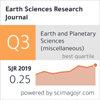伊拉克库尔德斯坦地区Gole地区Gimo大理岩的岩石学地球化学特征:对其原岩成因和沉积环境的制约
IF 0.5
4区 地球科学
Q4 GEOSCIENCES, MULTIDISCIPLINARY
引用次数: 0
摘要
确定大理岩的岩相和地球化学特征对于确定其碳酸盐原岩形成的古环境环境至关重要。本研究采用野外测绘、岩石学和地球化学技术相结合的方法,对伊拉克东北部库尔德斯坦地区戈勒地区大型Gimo大理石的岩石成因进行了研究。对这些大理石的岩石学检查表明,所有样品的矿物成分相似,除了提供矿化证据的不透明颗粒外,还出现了同源变晶和镶嵌结构。地球化学分析表明,大理岩的平均碳酸钙含量为94.96%;因此,该大理石在岩性上具有纯方解石大理石的特征。在大多数样品中,二氧化硅含量低于2wt.%,高值与石英细脉有关。一系列地球化学指数和后太古宙澳大利亚页岩(PAAS–归一化稀土元素(REE)模式)表明,石灰岩原岩沉积在大陆边缘的浅水近岸海洋环境中,碎屑物质的输入非常低。Ce负异常表明Gimo大理岩的原岩为沉积成因的碳酸盐岩。本文章由计算机程序翻译,如有差异,请以英文原文为准。
Petrographic and geochemical features of Gimo marble, Gole area, Kurdistan Region, Iraq: constraints on its protolith's origin and depositional environment
It is essential to identify marbles' petrographic and geochemical characteristics to determine the palaeo-environmental settings where their carbonate protoliths formed. The petrogenesis of massive Gimo marbles in the Gole area, Kurdistan Region of northeast Iraq, was investigated in this study through a combination of field mapping, petrographic, and geochemical techniques. Petrographic examination of these marbles reveals that mineral compositions are similar in all samples, with both homeoblastic and mosaic textures occurring, in addition to opaque grains that provide evidence of mineralization. Geochemical analyses show that the average calcium carbonate content of the marble is 94.96%; hence, the marble is lithologically characterized as a pure calcite marble. In most samples, the silica content was below 2 wt.%, with high values related to quartz veinlets. A range of geochemical indices and Post-Archean Australian Shale (PAAS–normalized rare earth element (REE) patterns) suggest that the limestone protolith was deposited in a shallow, near-shore marine environment on a continental margin, with very low input of detrital material. The negative Ce anomalies indicate that the protoliths of the Gimo marbles were carbonate rocks of a sedimentary origin.
求助全文
通过发布文献求助,成功后即可免费获取论文全文。
去求助
来源期刊

Earth Sciences Research Journal
地学-地球科学综合
CiteScore
1.50
自引率
0.00%
发文量
0
审稿时长
>12 weeks
期刊介绍:
ESRJ publishes the results from technical and scientific research on various disciplines of Earth Sciences and its interactions with several engineering applications.
Works will only be considered if not previously published anywhere else. Manuscripts must contain information derived from scientific research projects or technical developments. The ideas expressed by publishing in ESRJ are the sole responsibility of the authors.
We gladly consider manuscripts in the following subject areas:
-Geophysics: Seismology, Seismic Prospecting, Gravimetric, Magnetic and Electrical methods.
-Geology: Volcanology, Tectonics, Neotectonics, Geomorphology, Geochemistry, Geothermal Energy, ---Glaciology, Ore Geology, Environmental Geology, Geological Hazards.
-Geodesy: Geodynamics, GPS measurements applied to geological and geophysical problems.
-Basic Sciences and Computer Science applied to Geology and Geophysics.
-Meteorology and Atmospheric Sciences.
-Oceanography.
-Planetary Sciences.
-Engineering: Earthquake Engineering and Seismology Engineering, Geological Engineering, Geotechnics.
 求助内容:
求助内容: 应助结果提醒方式:
应助结果提醒方式:


